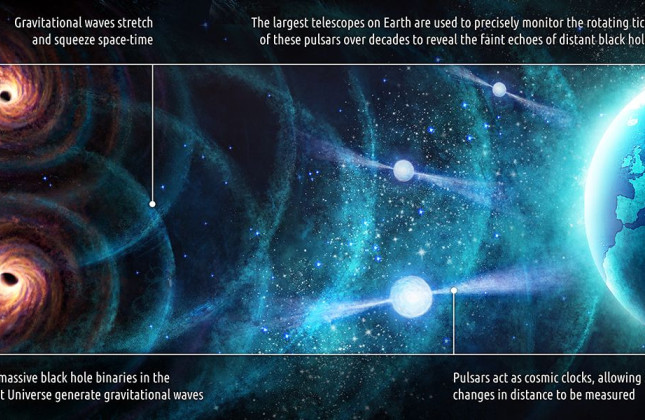In a series of papers published today in “Astronomy and Astrophysics”, scientists of the “European Pulsar Timing Array” (EPTA), in collaboration with Indian and Japanese colleagues of the “Indian Pulsar Timing Array” (InPTA), report on results from data collected over 25 years, which bring with them the promise of unprecedented discoveries in the study of the formation and evolution of our Universe and the galaxies that populate it.
The EPTA is a collaboration of scientists from more than ten institutions across Europe and brings together astronomers and theoretical physicists in order to use observations of ultra-regular pulses from extinguished stars called ‘pulsars’ to construct a Galaxy-sized gravitational wave detector.
“Pulsars are excellent natural clocks. We use the incredible regularity of their signals to search for minute changes in their ticking to detect the subtle stretching and squeezing of space-time by gravitational waves originating from the distant Universe”, explains Dr David Champion, senior scientist at the MPIfR in Bonn, Germany.
This gigantic gravitational wave detector - spanning from the Earth to 25 chosen pulsars across the Galaxy - makes it possible to probe gravitational wave frequencies much lower than those probed by other experiments. “We are opening a new window in the gravitational wave universe in the nanohertz regime, where we can observe unique sources and phenomena”, says Dr Caterina Tiburzi, a researcher at INAF, Osservatorio Astronomico di Cagliari, Italy.
Dr Stanislav Babak from Laboratory APC at CNRS, France is excited: “These ultra-low frequency gravitational waves carry information about some of the best-kept secrets of the Universe.” One such secret would be the cosmic population of binary black holes with masses millions to billions of times that of the Sun which form when galaxies merge. Dr Michael Keith, a lecturer at Jodrell Bank Centre for Astrophysics, UK, shares the excitement: “The results presented today mark the beginning of a new journey into the Universe to unveil some of its unsolved mysteries.”
“It’s been quite a journey,” says Dr Gemma Janssen, a scientist at ASTRON, the Netherlands Institute for Radio Astronomy, “since these results are based on decades of coordinated observing campaigns using the five largest radio telescopes in Europe”. These are the 100-m Effelsberg Radio in Germany, the Lovell Telescope of the Jodrell Bank Observatory in the United Kingdom, the Nançay Radio Telescope in France, the Sardinia Radio Telescope in Italy and the Westerbork Radio Synthesis Telescope in the Netherlands. “Once a month,” adds Dr Kuo Liu from the MPIfR in Bonn, “the European telescopes are additionally also recording data together to give an extra boost of sensitivity, comparable to the largest radio telescope on Earth”. These observations have been complemented by data provided by InPTA, leading to the development of a uniquely sensitive dataset.
The announcement of the EPTAs results is coordinated with similar publications by other collaborations across the world, namely the Parkes-based Australian, Chinese, and North-American pulsar timing array (PTA) collaborations, abbreviated as the PPTA, CPTA and NANOGrav, respectively. Astronomers are confident that what they see are signatures of gravitational waves as their results are consistent with and supported by similar data and results across all PTA collaborations.
Explaining the importance of the EPTA result, Dr Siyuan Chen, formerly working at CNRS Orléans and Paris Observatory, France (now at Peking University, China) says “The uniquely long and dense data set of the EPTA promises to provide the best handle on the physics of the merging galaxies by widening the frequency window probed.” The length and density of the data set determines the orbital periods that a black hole binary system can be in principle be detected with, here covering a period range from months up to about 50 years.
The analysis of the EPTA data presented today is in line with what astrophysicists expect. Prof. Alberto Vecchio from the University of Birmingham, UK, nevertheless points out that, “The gold standard in physics to claim the detection of a new phenomenon is that the result of the experiment has a probability of occurring by chance less than one time in a million.” The result reported by EPTA - as well as by the other international collaborations - does not yet meet this criterion, “but work is already in progress”, as Dr Golam Shaifullah, a postdoctoral researcher at Universitá degli Studi di Milano-Bicocca, Italy, explains. “Scientists from most of the leading PTAs are combining their data sets under the auspices of the International Pulsar Timing Array.” The aim is to expand the current datasets, by exploiting an array consisting of over 100 pulsars, observed with thirteen radio telescopes, and agglomerating thousands of observations for each pulsar, which should allow the astronomers to obtain irreproachable proof of having expanded the gravitational wave window on the Universe.
Papers:
https://arxiv.org/abs/2306.16224
https://arxiv.org/abs/2306.16225
https://arxiv.org/abs/2306.16214
